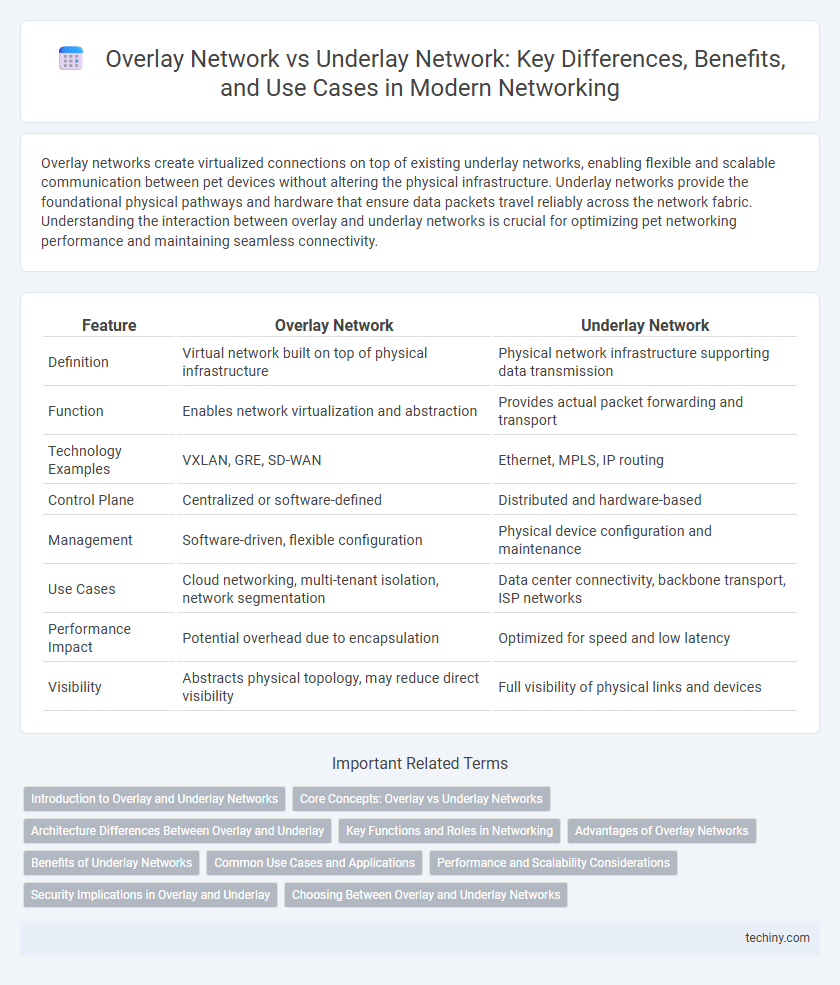Overlay networks create virtualized connections on top of existing underlay networks, enabling flexible and scalable communication between pet devices without altering the physical infrastructure. Underlay networks provide the foundational physical pathways and hardware that ensure data packets travel reliably across the network fabric. Understanding the interaction between overlay and underlay networks is crucial for optimizing pet networking performance and maintaining seamless connectivity.
Table of Comparison
| Feature | Overlay Network | Underlay Network |
|---|---|---|
| Definition | Virtual network built on top of physical infrastructure | Physical network infrastructure supporting data transmission |
| Function | Enables network virtualization and abstraction | Provides actual packet forwarding and transport |
| Technology Examples | VXLAN, GRE, SD-WAN | Ethernet, MPLS, IP routing |
| Control Plane | Centralized or software-defined | Distributed and hardware-based |
| Management | Software-driven, flexible configuration | Physical device configuration and maintenance |
| Use Cases | Cloud networking, multi-tenant isolation, network segmentation | Data center connectivity, backbone transport, ISP networks |
| Performance Impact | Potential overhead due to encapsulation | Optimized for speed and low latency |
| Visibility | Abstracts physical topology, may reduce direct visibility | Full visibility of physical links and devices |
Introduction to Overlay and Underlay Networks
Overlay networks create virtualized network layers on top of physical underlay networks, enabling flexible and scalable connectivity abstractions. Underlay networks consist of the physical infrastructure, including routers, switches, and links, providing the fundamental data transport and routing services. Understanding the roles of overlay and underlay networks is essential for designing efficient software-defined networking (SDN) and network virtualization solutions.
Core Concepts: Overlay vs Underlay Networks
Overlay networks operate by creating virtualized, logical links on top of physical underlay networks, enabling flexible, scalable, and simplified network management. Underlay networks provide the fundamental physical infrastructure, including routers and switches, that carry actual data packets across the network's core. Understanding the relationship between overlay and underlay networks is essential for optimizing data routing, enhancing network reliability, and supporting modern applications like SDN and NFV.
Architecture Differences Between Overlay and Underlay
Overlay networks abstract the physical underlay by creating virtualized network layers using encapsulation protocols like VXLAN or GRE to facilitate scalable, flexible connectivity across distributed environments. Underlay networks consist of the physical infrastructure, including routers, switches, and links, responsible for delivering actual data packets based on IP routing and traffic engineering protocols such as OSPF or BGP. The architectural distinction centers on the overlay's role in enabling logical topologies and network segmentation independently from the physical topology managed by the underlay.
Key Functions and Roles in Networking
Overlay networks create virtualized network layers that run on top of existing physical infrastructure, enabling flexible routing, segmentation, and improved traffic management. Underlay networks consist of the physical hardware and protocols that provide the foundational connectivity, ensuring data delivery through stable, high-capacity links. Overlay key functions include abstraction and network virtualization, while underlay focuses on reliability, performance, and direct packet forwarding.
Advantages of Overlay Networks
Overlay networks offer enhanced flexibility by enabling virtual network creation independent of the physical infrastructure, which accelerates deployment and management. They improve scalability through seamless integration of multiple underlay networks, supporting complex topologies and dynamic resource allocation. Security benefits arise from encapsulation techniques that isolate traffic within virtual tunnels, reducing exposure to underlying network vulnerabilities.
Benefits of Underlay Networks
Underlay networks provide a robust physical infrastructure that ensures reliable packet forwarding and optimal path selection across devices. Their direct management of IP routing enhances network performance, reduces latency, and supports scalable traffic engineering. Underlay networks also improve security by isolating the physical transport layer from virtualized overlay configurations, enabling greater control and stability.
Common Use Cases and Applications
Overlay networks are commonly used in cloud computing and data center virtualization for creating scalable virtual networks independent of physical infrastructure, enabling efficient resource pooling. Underlay networks ensure reliable, high-performance physical connectivity across data centers and enterprise networks, supporting foundational IP routing and traffic forwarding. Use cases for overlay networks include SD-WAN, VPNs, and network virtualization, while underlay networks are critical for MPLS, traditional WANs, and physical infrastructure management.
Performance and Scalability Considerations
Overlay networks abstract the underlying physical infrastructure, enabling enhanced scalability by supporting dynamic routing and virtualized network segments, which optimize traffic flow without altering the underlay. Underlay networks provide the foundational hardware and physical connectivity, with performance directly influenced by topology, bandwidth, and latency constraints inherent to the physical devices and protocols. Effective network design balances overlay flexibility with underlay capacity to achieve high throughput, reduced latency, and seamless scalability across distributed environments.
Security Implications in Overlay and Underlay
Overlay networks enhance security by encapsulating data packets within encrypted tunnels, isolating traffic from the underlying infrastructure and reducing exposure to external threats. Underlay networks rely on traditional physical security measures, making them more vulnerable to attacks targeting hardware and network devices. Understanding the distinct security models of overlay and underlay networks is critical for designing robust, multi-layered defenses in modern distributed network architectures.
Choosing Between Overlay and Underlay Networks
Choosing between overlay and underlay networks depends on factors like scalability, flexibility, and control over physical infrastructure. Overlay networks offer enhanced virtualized connectivity and simplified management across diverse underlay environments, making them ideal for dynamic and multi-tenant scenarios. Underlay networks provide direct hardware-level performance and predictable latency, essential for applications requiring low-latency and high reliability.
Overlay Network vs Underlay Network Infographic

 techiny.com
techiny.com